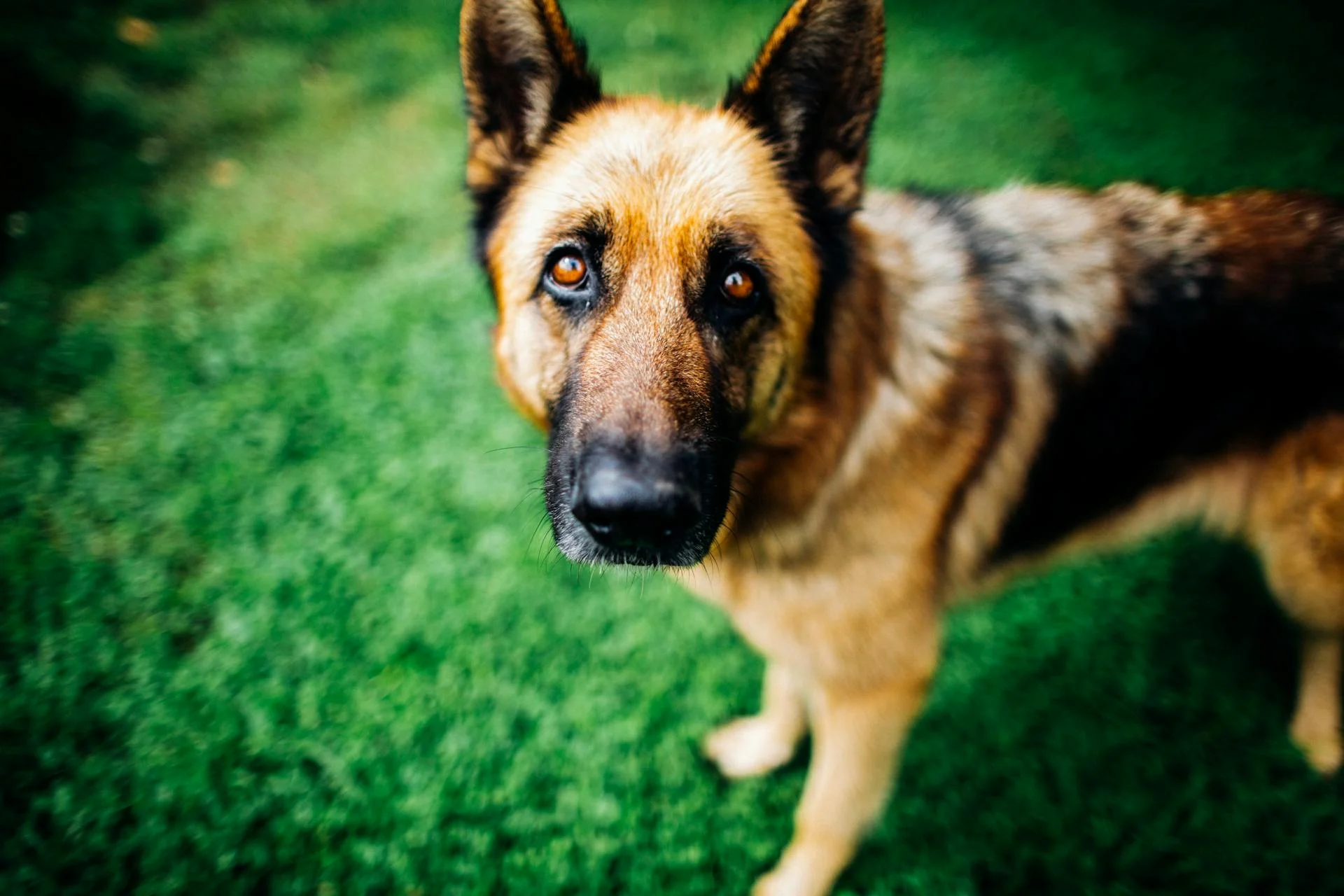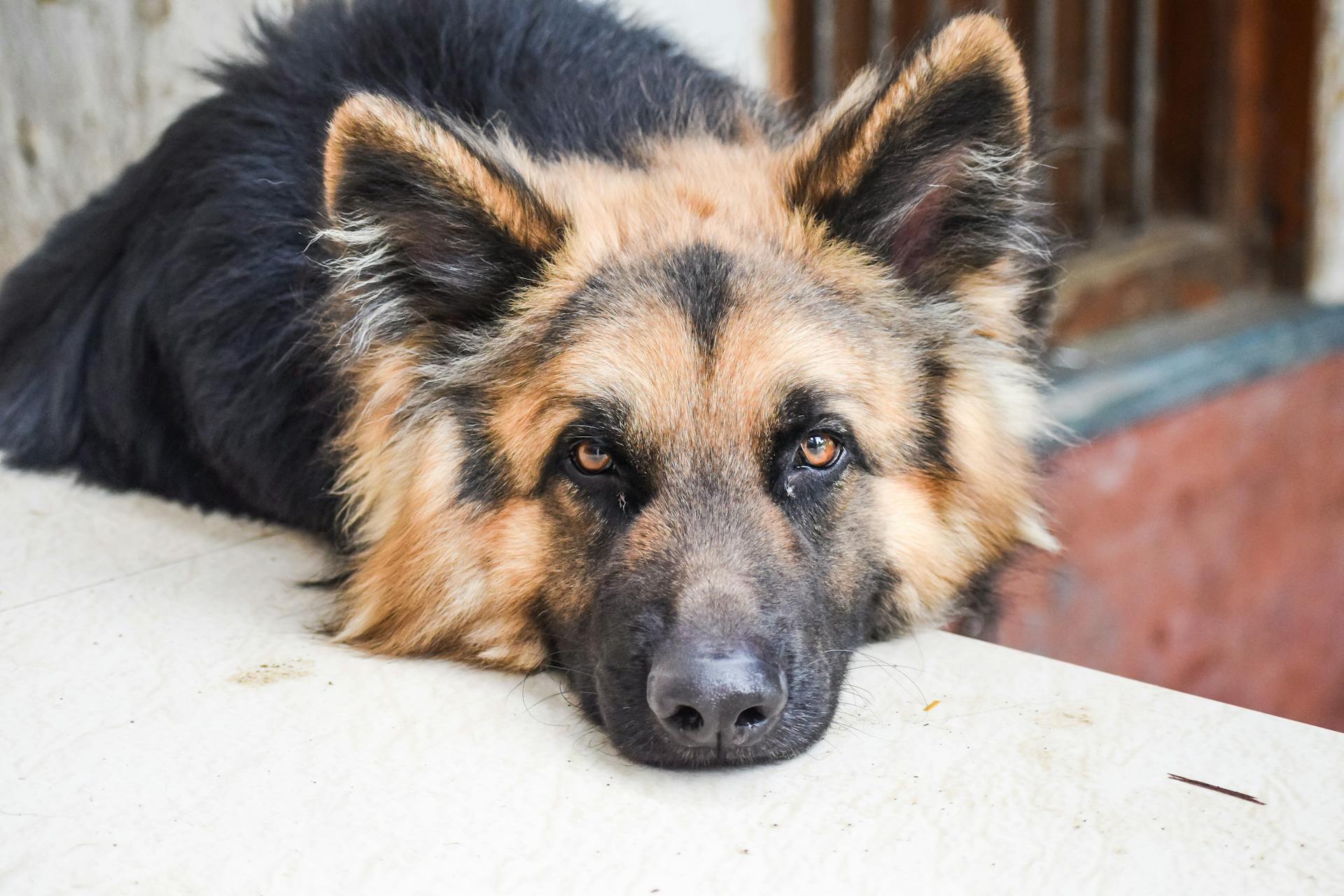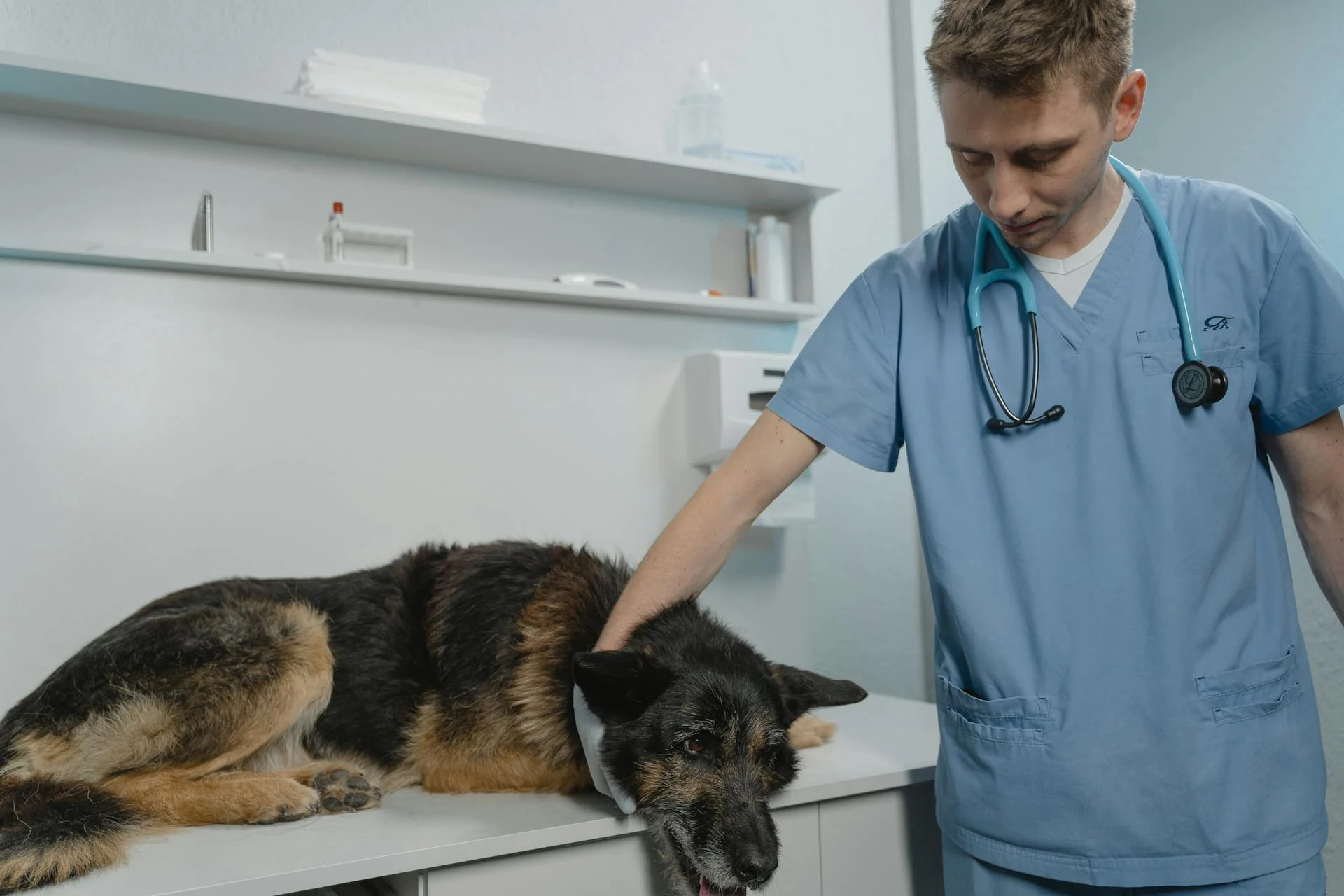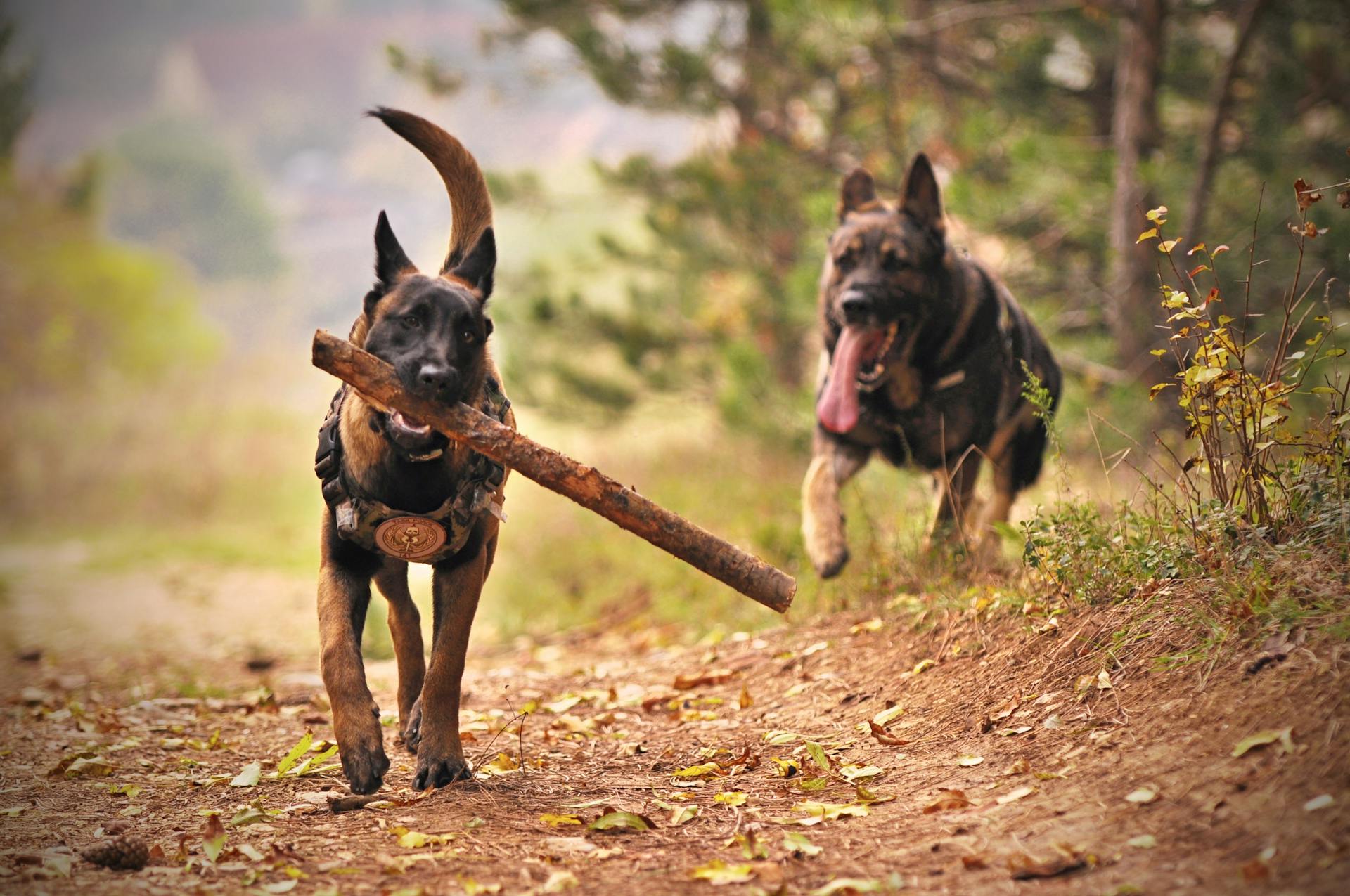
German Shepherds are highly intelligent dogs, ranking 3rd in Stanley Coren's book "The Intelligence of Dogs" for working and obedience intelligence.
Their high energy levels require regular exercise, ideally at least 30 minutes a day.
German Shepherds are natural herders and thrive in roles that challenge their minds and bodies, such as search and rescue or guiding the blind.
They are generally healthy dogs, but can be prone to hip dysplasia and digestive issues, which is why regular check-ups with a veterinarian are crucial.
A well-balanced diet and plenty of physical activity can help prevent these issues and ensure a long, happy life for your German Shepherd.
Breed Information
German Shepherds are a popular breed known for their intelligence, loyalty, and protective nature. They originated in Germany in the late 1800s.
Their high energy level and strong herding instincts make them well-suited for active families or individuals who enjoy outdoor activities. German Shepherds require regular exercise and mental stimulation to prevent boredom and destructive behavior.
On average, German Shepherds weigh between 75 and 95 pounds and stand between 24 and 26 inches tall at the shoulder.
Types
The German Shepherd breed has a rich history and a diverse range of types. While the breed is singular in standard, it manifests a variety of appearances, primarily distinguished by color and coat type.
The German Shepherd breed has a standard focused on the dog's ability and character, with the primary division being between working lines and show lines. This division is not necessarily a reflection of the dog's temperament or working ability, but rather a distinction between dogs bred for performance and those bred for conformation.
Some German Shepherds have a striking all-black coat, known as the Black German Shepherd, which is both rare and sought after. They possess all the breed's esteemed characteristics, with their color being the main distinction.
The Blue German Shepherd is a rarer color variation, with a unique coat color due to a dilution gene. This color variation is not a separate breed, but rather a distinct appearance within the breed.
For your interest: Female Black German Shepherds
The German Shepherd breed also comes in a variety of coat types, including the Long Haired German Shepherd, which has a coat that's longer and softer than the typical double coat. This coat type requires additional grooming but is highly valued for its beauty.
Sable German Shepherds have a multi-colored coat pattern that gives them a distinctive, wolf-like appearance. This coloration is one of the most common in working lines.
Here are some of the notable coat and color varieties of German Shepherds:
- Black German Shepherd: Known for their striking all-black coat.
- Blue German Shepherd: A rarer color variation with a unique coat color due to a dilution gene.
- Long Haired German Shepherd: With a coat that's longer and softer than the typical double coat.
- Sable German Shepherd: With a multi-colored coat pattern that gives them a distinctive, wolf-like appearance.
Breed Data
The German Shepherd breed is an impressive one, and understanding its vital statistics can give you a better idea of what to expect from this loyal companion. They originated in Germany, which might explain their name.
Their height ranges from 22 to 26 inches, which is quite a range. You can expect them to weigh between 75 and 95 pounds, depending on their lineage.
Their life span is relatively short, ranging from 7 to 10 years. This is a common life expectancy for many breeds.
Here's a brief overview of the German Shepherd breed in a table format:
History of
The German Shepherd breed has a rich and fascinating history that spans over a century. The breed was created by Captain Max von Stephanitz, a former military man who wanted to breed a perfect herding dog.
Von Stephanitz was instrumental in standardizing the breed and valued utility and intelligence over appearance. He discovered the founding sire of the breed, Horand von Grafrath, in 1899.
The first German Shepherd was exported to the United States in 1904, just five years after the breed was created. The breed quickly gained popularity in America.
Rin Tin Tin, a German Shepherd rescued from World War I, became a famous movie star in the 1920s and helped popularize the breed. His descendants went on to play important roles in both World War II and as service dogs.
The breed was officially recognized by the AKC in 1908, solidifying its place in American dog history.
A fresh viewpoint: Max Von Stephanitz
Health and Wellness
German Shepherds are prone to certain health issues, with up to 50 hereditary diseases possible.
Maintaining a healthy weight is crucial for preventing joint issues, such as hip and elbow dysplasia, and other health problems like diabetes. A balanced diet tailored to their life stage, regular exercise, and mental stimulation are key factors in maintaining their overall health.
Hip dysplasia is a hereditary concern that entails the improper fitting of the femur into the hip joint's pelvic socket. Hip dysplasia can manifest with or without apparent symptoms, and screening for hip dysplasia through X-ray assessments is conducted by organizations like the Orthopedic Foundation for Animals or the University of Pennsylvania Hip Improvement Program.
Elbow dysplasia is primarily found in large breeds, resulting from differential growth rates among the elbow's three constituent bones, causing joint instability. The consequence is painful lameness, and veterinary recommendations may encompass surgical intervention or pain management medications.
Bloat, or gastric dilatation-volvulus, is a life-threatening situation predominantly affecting deep-chested large dogs. It occurs when the stomach distends due to gas or air and subsequently twists. Immediate medical attention is crucial to prevent shock and possible fatality.
Here are some common health issues German Shepherds may experience:
- Hip Dysplasia
- Elbow Dysplasia
- Gastric Dilatation-Volvulus (Bloat)
- Degenerative Myelopathy
- Exocrine Pancreatic Insufficiency (EPI)
- Allergies
German Shepherds typically enjoy good health, but they can inherit susceptibility to specific health conditions. Regular veterinary check-ups and maintaining a healthy weight can help manage joint issues like hip and elbow dysplasia.
The average German Shepherd lifespan is 7–10 years, and they are prone to several health problems. Purchasing pet insurance for your dog may be a smart investment when you bring home a German Shepherd puppy.
Incorporating quality probiotics into a German Shepherd's diet can aid in maintaining a healthy gut flora. Joint support is another critical consideration, given the breed's susceptibility to joint issues.
Care and Upkeep
German Shepherds are large and athletic dogs that require frequent exercise, especially activities that challenge both their body and mind, such as agility training or tracking.
They love to run and play, but they're not the best retrievers, so be prepared for that. Most German Shepherds are strong swimmers, but they can be high jumpers, so make sure your fence is at least 4 feet high.
German Shepherds have a thick double coat that sheds a lot, especially twice a year when the coat is changing for warmer or colder weather. You'll need to brush them daily during shedding season and at least once or twice a week otherwise.
A fresh viewpoint: Are German Shepherds Clingy
They're prone to skin problems that cause itching, fur loss, and odors, so be prepared for regular bathing and extra attention to their skin. German Shepherds are generally hardy in cold and moderately warm weather.
Feeding a large-breed puppy food during their development can help prevent hip dysplasia and other joint disorders. However, German Shepherds are also susceptible to gastric dilatation-volvulus (GDV), a life-threatening condition that requires immediate attention.
German Shepherds need regular exercise to prevent boredom and undesirable behaviors, such as digging or excessive barking. They require both physical engagement, like jogging or playing at a dog park, and mental stimulation, like agility or obedience training.
To prevent dental issues, ingestion of harmful substances, or choking hazards, provide your German Shepherd with safe chew toys and bones. They have a strong jaw and a tendency to chew, so make sure to keep an eye on them.
German Shepherds have a double coat that sheds heavily, so be prepared for regular grooming, ideally two to three times a week. They also need monthly nail trims and weekly ear checks to maintain their hygiene.
Bathing should be done judiciously to avoid stripping their coat's essential oils, which sustain its health. Regular brushing and a reliable vacuum cleaner can help manage their shedding, but no foolproof remedy exists.
Nutrition and Feeding
German Shepherds have unique nutritional needs due to their large size and high energy demands. A high-quality, age-appropriate diet is essential to meet their nutritional needs.
For German Shepherd puppies, it's crucial to feed a low-calorie diet to regulate their growth rate and prevent bone-related issues. They should not engage in vigorous activities like running or jumping until their joints are fully developed, around two years of age.
Feeding your German Shepherd three to four times a day is recommended for puppies, and twice a day for adult dogs. The specific food and amount to feed should be determined by your veterinarian, taking into account your dog's lifestyle and health.
A diet approved by the Association of American Feed Control Officials (AAFCO) ensures that the ingredients meet established standards, and basic vitamins and mineral supplements are typically not needed.
For more insights, see: German Shepherd Dogs Puppies
Gastrointestinal Issues
German Shepherds are prone to gastrointestinal problems, including bloat, which is a life-threatening condition requiring immediate veterinary attention.
A diet tailored to their specific needs can help prevent serious complications.
Monitoring for symptoms like abdominal swelling or distress can alert you to potential issues before they become severe.
With up to 50 hereditary diseases, understanding these common health concerns is crucial for every German Shepherd owner.
Feeding your German Shepherd the right dog food can make a big difference in their overall health and well-being.
German Shepherds have sensitive stomachs and are prone to allergies, so selecting the right dog food is essential.
A German Shepherd's average lifespan is 7-10 years, and their dietary needs should be considered in order to support their health and activity level.
Nutrition and Feeding
German Shepherds require a high-quality, age-appropriate diet to meet their nutritional needs. These diets are usually labeled puppy, adult, or senior. A large-breed formulation may be appropriate.
AAFCO-approved dog food is highly recommended, as it ensures the ingredients meet established standards. Basic vitamins and mineral supplements are typically not needed if your dog's food is AAFCO-approved.
Avoid offering your German Shepherd table scraps, as they can cause stomach upset. Human foods also have a much higher fat content than dog food, which can cause pancreatitis and obesity.
Feeding smaller, frequent meals instead of one big meal every day will help prevent bloat and GDV (gastric dilatation-volvulus). This breed is prone to gastrointestinal problems, including bloat, which is a life-threatening condition requiring immediate veterinary attention.
German Shepherds require a diet high in protein to support their muscular physique and active lifestyle. High-quality protein sources, such as chicken, are highly digestible and ensure the dog can fully utilize the nutrients.
In general, German Shepherd puppies should be fed three to four times per day, and adult dogs should be fed twice a day. How much you feed is determined by the specific food your dog eats, as well as their lifestyle and health.
Work with your veterinarian to determine how much food your dog should eat.
Here's an interesting read: Bloat in German Shepherd Dogs
Training and Behavior
Training a German Shepherd requires a consistent, patient, and understanding approach. They thrive on clear guidance, positive reinforcement, and mental stimulation.
Their intelligence and versatility make them excel in specific tasks or jobs, such as search and rescue, obedience competitions, or as service dogs. Tailoring training to their strengths and interests can lead to a more fulfilling experience for both the dog and owner.
German Shepherds are naturally high-energy dogs that need a job to fulfill their high drives, such as territorial protectiveness, chasing prey, and other work. Without a job, they can become hyperactive, anxious, and sometimes exhibit aggressive behavior.
A consistent reward system, such as treats or toys, helps strengthen the human-animal bond and encourages good behavior. German Shepherds respond exceptionally well to positive reinforcement techniques and focus on rewarding desired behaviors instead of punishing negative ones.
Training should start early, as soon as the puppy comes home, with early socialization and puppy training classes. Consistency in commands, rules, and expectations is also vital in training your German Shepherd, and everyone in your household should be on the same page.
Proper socialization involves exposing your German Shepherd to a variety of people, animals, environments, and situations in a controlled and positive manner. By focusing on these strategies, you can ensure your German Shepherd becomes a well-mannered and sociable member of your family.
Behavior and Training
Training a German Shepherd requires a consistent, patient, and understanding approach. They thrive on clear guidance, positive reinforcement, and mental stimulation.
German Shepherds are highly trainable, but punishment or force-based training is not needed. Once they understand what you want, they're eager to please. Their motivation to work for reward is much higher than any motivation to avoid punishment.
A German Shepherd's high "drives" can make them hyperactive, anxious, and sometimes aggressive if not given a job that fulfills these drives. Show-type German Shepherds still need lots of positive reinforcement training, physical exercise, and mental stimulation to support a well-balanced life.
Consistency in commands, rules, and expectations is vital in training your German Shepherd. Ensure that everyone in your household is on the same page with commands and rules to avoid confusing your dog.
Here are some key behaviors to focus on when training a German Shepherd:
- Basic manners and obedience
- Interacting with other dogs and people positively
- Responding to commands and rewards
- Exhibiting confidence and calmness in new situations
Proper socialization involves exposing your German Shepherd to a variety of people, animals, environments, and situations in a controlled and positive manner. Well-socialized dogs are more likely to be confident, calm, and less reactive in new or unfamiliar situations.
Similar Breeds
The German Shepherd is a breed that has inspired the development of several similar breeds, each with their own unique characteristics. These breeds are often associated with the German Shepherd due to their shared ancestry and similar appearance.
The Shiloh Shepherd, for example, was developed to meet specific desires for temperament and size. They are known for their calm and gentle nature, making them a great choice for families.
The Blue Bay Shepherd, on the other hand, was bred to have a distinctive blue-gray coat. This breed is often sought after by those who want a German Shepherd-like dog with a unique twist.
The King Shepherd is another breed that has been developed from the original German Shepherd lineage. They are known for their large size and regal demeanor, making them a popular choice among those who want a majestic companion.
Each of these breeds has its own strengths and weaknesses, and it's essential to research and understand their specific needs before deciding to bring one home.
Suggestion: German Dogs Breeds
Size and Lifespan
German Shepherds are a medium to large breed, with adult dogs typically weighing between 50 to 90 pounds and standing between 22 to 26 inches tall at the shoulders.
Their size is a reflection of their strong and robust build, which is essential for their historical role as herding and working dogs. A well-proportioned body structure, characterized by a level back, strong hindquarters, and deep chest, further emphasizes their agility and strength.
To maintain an ideal weight and overall health, regular exercise, a balanced diet, and routine veterinary care are crucial. This can help ensure a German Shepherd lives a full and healthy life, with an average lifespan of 9 to 13 years.
Here is a breakdown of the average weight and height measurements for German Shepherds:
How Long They Live
German Shepherds are a beloved breed, and one of the most common questions I get asked is how long they live. On average, German Shepherds live between 9 to 13 years.
Genetics play a significant role in determining a German Shepherd's lifespan, and regular health screenings can help identify and manage genetic predispositions early on. This can make a big difference in their overall health and longevity.
A balanced diet tailored to their specific health needs can prevent obesity and support overall health, potentially extending their lifespan. I've seen many German Shepherds thrive on a well-balanced diet, and it's amazing how much of a difference it can make.
Regular physical activity is also crucial for a German Shepherd's longevity. Exercise helps maintain a healthy weight, improves cardiovascular health, and keeps joints flexible, all of which are vital for a long and healthy life.
Here's a quick rundown of the factors that can impact a German Shepherd's lifespan:
- Genetics: 9-13 years
- Diet: 9-13 years
- Exercise: 9-13 years
- Preventative Care: 9-13 years
By focusing on preventative healthcare, proper nutrition, regular exercise, and mental stimulation, you can help your German Shepherd live a full and healthy life.
Weight and Height
German Shepherds typically have a height range of 22 to 26 inches at the shoulders, with males standing slightly taller than females.
Their weight is just as impressive, ranging from 50 to 90 pounds, with males tending to be heavier than females.
A well-proportioned body structure, characterized by a level back, strong hindquarters, and deep chest, contributes to their agility and strength.
To maintain an ideal weight and overall health, regular exercise, a balanced diet, and routine veterinary care are crucial.
German Shepherds' size serves as a reflection of their multifaceted nature, making them versatile companions that excel in various roles such as search and rescue, police work, service, and family pets.
Temperament and Personality
German Shepherds are naturally playful and energetic, making them great companions for families with kids and the elderly. They're also highly intelligent and trainable, which is why they're often used by military and police forces for tasks like tracking and detection.
German Shepherds have a tendency to be protective of their families, but this can be misdirected if they're not properly trained. Without guidance, they can become the dominant one in the relationship, so it's essential to establish clear boundaries and rules.
These dogs are loyal and watchful, but may be reserved around strangers. With proper socialization, they can learn to interact with new people and environments with confidence and ease. German Shepherds thrive on purposeful tasks and mental stimulation, so they need plenty of exercise and engagement to prevent boredom and restlessness.
Changes Over Time
The German Shepherd breed has undergone significant changes over time. The breed's trainability and athleticism made them a popular choice for military roles in World War I, where they worked as messengers, guard dogs, and scouts.
Many British and American service members were impressed by the breed's working ability and began their own military canine training programs. Some even brought these dogs back to their home country as personal pets after deployment.
Curious to learn more? Check out: German Military Dogs
The breed's popularity surged between the first and second world wars, thanks in part to their visibility in Hollywood movies. Unfortunately, with the start of World War II, the breed became less popular due to anti-German sentiment.
The breed regained its popularity by the 1960s and is currently the second most popular dog breed in the United States.
Temperament
German Shepherds are playful and energetic dogs, making them great companions for children and the elderly. They are devoted, vigilant, and protective family members.
Their protective tendencies can be misdirected if they're not trained properly, so they need guidance and training to behave well. Without a firm hand, a German Shepherd can become the dominant one in the relationship.
Some German Shepherds can be overly aggressive towards people and other pets, but this behavior can be corrected with training. They will bark in response to perceived threats, but they're not overly noisy or excitable.
Expand your knowledge: Are German Shepherds Protective
German Shepherds are intelligent and trainable, but they can be stubborn at times, testing a handler's determination. They enjoy training and learn quickly, but they need clear guidance and a firm hand.
German Shepherds are loyal and watchful dogs, making them excellent watchdogs and guardians. They're gentle around their family but may be reserved around strangers.
German Shepherds require a lot of exercise for both their physical and mental health, and without it, they'll develop unfavorable behaviors due to irritation and pent-up energy.
Pop Culture and Fun Facts
German Shepherds have made a name for themselves in pop culture, and it's easy to see why - they're intelligent, loyal, and highly trainable.
The breed's popularity in media can be attributed to their ability to be well-trained and responsive. You've probably seen German Shepherds in action on TV and in movies, working as police or military dogs.
In fact, German Shepherds are one of the most popular breeds used as police or military working dogs, and it's not just because of their physical abilities - they're also highly trainable, loyal, and have a strong desire to work.
Here are some fun facts about German Shepherds in pop culture:
- German Shepherds are popular both as pets and as working dogs in media.
- The breed's intelligence and trainability make them a favorite among filmmakers and producers.
American History

The German Shepherd has a rich history in America that's worth exploring. The breed was first introduced to the United States in 1904, just five years after its creation in Germany.
Rin Tin Tin, a German Shepherd, became a famous canine movie star during the 1920s. He was rescued as a puppy from the battlefield by American soldier Lee Duncan during World War I.
Rin Tin Tin's acting career was carried on by his descendants into the late 1950s. His offspring were not just great animal actors, but also helped with important work during World War II.
Rin Tin Tin III trained more than 5,000 dogs for the war effort in World War II.
Fun Activities for
German Shepherds are naturally talented and love to stay active. They enjoy and excel in various dog sports and activities.
Nosework is one of their favorite pursuits, where they use their incredible sense of smell to track down hidden scents.

Their tracking skills are also top-notch, making them perfect for search and rescue missions.
Service Animal Training is another area where German Shepherds shine, as they learn to assist people with disabilities.
Disc Dog is a fun activity that challenges their agility and reaction time.
If you're looking for a fun way to engage your German Shepherd, consider trying Herding or Treibball, which utilize their herding instincts.
Agility training is also a great way to keep them physically and mentally stimulated.
Here are some fun activities for German Shepherds:
- Nosework
- Tracking
- Service Animal Training
- Search and Rescue
- Disc Dog
- Agility
- Herding / Treibball
Fun Facts
German Shepherds are large, athletic dogs, with males weighing between 65 and 90 lbs. when fully grown and females weighing between 50 and 75 lbs.
The dog sport of Schutzhund, which combines tracking, obedience, and protection work, was developed specifically to test the instincts and physical ability of the German Shepherd Dog breed.
German Shepherds are highly trainable, loyal, and have a strong desire to work, making them one of the most popular dog breeds used as police or military working dogs.

In fact, dogs that exhibit actual aggression in these lines of work are often disqualified from the training program.
Interestingly, the first-ever guide dog for the visually impaired was a female German Shepherd Dog named Buddy, who worked as Morris Frank's guide dog from 1928 until she died ten years later.
Here are some fun facts about German Shepherd colors:
- Most commonly recognized for their black and tan coloring, there are actually a variety of colors within the breed.
- One of these colors is the "panda" German Shepherd, which has a piebald coat (white, black, and tan) caused by a rare genetic mutation.
German Shepherds have also been involved in some remarkable work, such as Arrow, a German Shepherd who earned the Guinness World Record for being the first skydiving anti-poaching dog in 2016.
Pop Culture
German Shepherds have been a staple in pop culture, often starring as loyal and intelligent companions in movies and TV shows.
Their intelligence and trainability make them a popular choice for roles in media, from police dogs to family pets.
You might have seen German Shepherds as heroes in films like "I Am Legend" or "The Shaggy Dog".
Their versatility and trainability also make them a popular choice for search and rescue missions, as well as therapy work.
In fact, German Shepherds are often used as service dogs, assisting people with disabilities and providing emotional support.
Frequently Asked Questions
What are 5 facts about German Shepherds?
Here are 5 key facts about German Shepherds: They're one of the smartest dog breeds, made famous by World War I, and are a popular choice in America. German Shepherds have also been recognized for their talents, including having stars on the Walk of Fame.
What are German Shepherds weakness?
German Shepherds are prone to hind leg weakness, which can lead to severe arthritis and mobility issues. This weakness can cause their legs to appear bent and may require special care and attention.
What are the basic needs of a German Shepherd?
German Shepherds need plenty of exercise, social interaction, and direction to thrive. They are best suited to living in the house as part of the family
Featured Images: pexels.com


